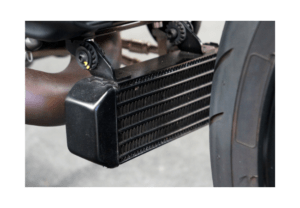If you’re a DIYer who loves tinkering with automobiles, then you’ve probably heard of transmission oil coolers. But do you really understand what they are and how important their role is in your vehicle’s performance? This blog post will provide an overview of what is a transmission oil cooler, explaining why they’re essential for maintaining your car or truck’s optimal performance and helping extend its longevity.
By looking at different types of transmission oil coolers, analyzing their features and applications, as well as providing easy-to-understand installation instructions, we’ll help demystify the complex world of auto maintenance so that even newbies can get into the game. With just a few simple steps, you’ll have reliable cooling power that keeps your transmission running strong.
Contents
Does My Truck Need a Transmission Cooler?

Whether or not your truck needs a transmission cooler depends on a few factors, including the size and weight of your truck, how it’s used, and the conditions in which it’s operated. Generally speaking, larger trucks and those used for towing or hauling heavy loads may benefit from a transmission cooler. This is because these trucks put more stress on the transmission, which can cause the fluid to heat up more quickly.
When the transmission fluid gets too hot, it can break down more quickly and cause damage to the transmission. A transmission cooler can help to prevent this by dissipating the heat generated by the transmission and keeping the fluid at a more consistent temperature.
If you’re unsure whether or not your truck needs a transmission cooler, it’s a good idea to consult with a mechanic or transmission specialist. They can evaluate your specific truck and usage patterns and recommend the best course of action. In general, it’s better to err on the side of caution and install a transmission cooler if there’s any question as to whether or not it’s needed.
The cost of a transmission cooler is relatively low compared to replacing a damaged or worn-out transmission, so it’s often a wise investment to protect your vehicle and ensure it operates at its best.
How Does a Transmission Oil Cooler Work?
A transmission cooler works by dissipating heat from the transmission fluid as it circulates through the cooler. The cooler is typically installed in the vehicle’s front grille or in front of the radiator, where it can receive a flow of cool air. As the hot transmission fluid flows through the cooler, it is exposed to the cooler’s metal fins, which transfer the heat from the fluid to the surrounding air. This helps to lower the temperature of the transmission fluid before it returns to the transmission, which helps to prevent damage and extend the life of the transmission.
Transmission coolers come in a variety of sizes and designs, depending on the specific needs of the vehicle and the transmission. Some coolers use air-to-air cooling, which means they rely on the flow of air through the cooler to dissipate the heat from the fluid. Other coolers use liquid-to-liquid cooling, which means they use a separate system of coolant to transfer the heat from the transmission fluid.
In either case, the goal is the same: to keep the transmission fluid at a consistent temperature and prevent it from overheating. By installing a transmission cooler, you can help to protect your vehicle’s transmission and ensure that it operates smoothly and efficiently.
Transmission Oil Cooler Types
There are several types of transmission coolers available, each with its own unique features and benefits. One of the most common types is the tube-and-fin cooler, which uses a series of metal tubes and fins to transfer heat from the transmission fluid to the surrounding air. This type of cooler is simple and effective and is often used on vehicles with moderate to heavy towing or hauling needs.
Another type of transmission cooler is the plate-and-fin cooler, which uses a series of thin metal plates to transfer heat from the transmission fluid to the surrounding air. This type of cooler is typically more compact and efficient than tube-and-fin coolers and is often used on vehicles with limited space for a cooler.
Liquid-to-liquid coolers are another type of transmission cooler that uses a separate system of coolant to transfer heat away from the transmission fluid. This type of cooler is typically more complex and expensive than tube-and-fin or plate-and-fin coolers but can be more effective at maintaining a consistent temperature for the transmission fluid. Liquid-to-liquid coolers are often used on high-performance vehicles or vehicles that are used for racing or other demanding applications.
When choosing a transmission cooler, it’s important to consider factors such as the size and weight of your vehicle, how it’s used, and the conditions in which it operates. Consulting with a mechanic or transmission specialist can help you select the best type of cooler for your specific needs and ensure that it is installed correctly for optimal performance and longevity.
Benefits of a Transmission Oil Cooler
Installing a transmission oil cooler in your vehicle can provide several benefits. The primary benefit is that it helps to keep the transmission fluid at a consistent temperature, which can prevent damage to the transmission and extend its lifespan. When the transmission fluid gets too hot, it can break down more quickly and cause the transmission to fail. By installing a cooler, you can help to dissipate the heat generated by the transmission and keep the fluid at a safe and consistent temperature.
Another benefit of a transmission oil cooler is that it can help to improve the overall performance of your vehicle. When the transmission is operating at a consistent temperature, it can shift more smoothly and respond more quickly to your inputs. This can make your vehicle feel more responsive and enjoyable to drive, particularly if you use it for towing, hauling, or other demanding applications.
Finally, installing a transmission oil cooler can help to reduce the risk of costly repairs or replacements. The cost of a transmission cooler is relatively low compared to replacing a damaged or worn-out transmission, so it can be a wise investment to protect your vehicle and ensure it operates at its best. By taking care of your transmission and ensuring it stays cool, you can help to avoid costly breakdowns and keep your vehicle running smoothly for years to come.
FAQ’s
1. Is a transmission oil cooler necessary?
Overheated transmission fluid can wreak havoc and reduce the lifespan of your car’s transmission, especially when towing. Adding a cooler helps keep temperatures at an optimal level for maximum performance and longevity – so look into investing in one today.
2. What happens when your transmission cooler goes out?
When a transmission oil cooler hose fails your vehicle is in imminent danger of overheating, which can potentially lead to the breakdown of its entire system. Don’t let low fluid levels or blocked flow leave you stranded on the side of the road; be sure to replace that faulty hose before it’s too late.
3. Can you drive without a transmission cooler?
Don’t worry if you plan to take your car for a quick drive out to the store; it’s unlikely that the extra speed will cause any problems with the transmission fluid. So go ahead and make sure your ride is running smoothly.
Conclusion
The transmission oil cooler is an invaluable part of a vehicle’s cooling system. It helps to prevent overheating and ensures that the vital parts within the transmission are kept at the correct temperature. Regular maintenance such as flushing out the old fluid and changing filters is necessary to keep your transmission running optimally. Without a healthy cooler, you are running the risk of major damage to your car’s internals due to rising temperatures.
Furthermore, if you want an even better assurance for your car’s internal health than what a cooler provides, implementing additional cooling solutions such as extra fans or external radiators may be beneficial. The money spent on preventative measures will be much less than the cost of a major breakdown or repair due to neglected maintenance and excessive heat buildup in critical areas of a vehicle’s engine components.

1 thought on “What is a Transmission Oil Cooler – Top Benefits of Using One”
Comments are closed.